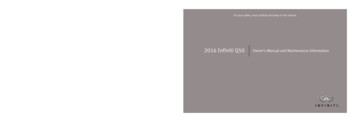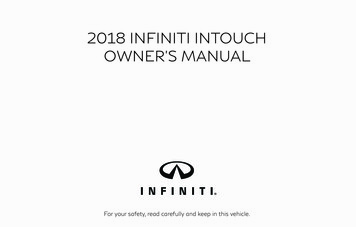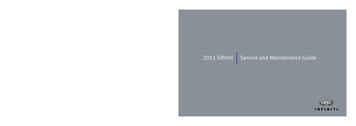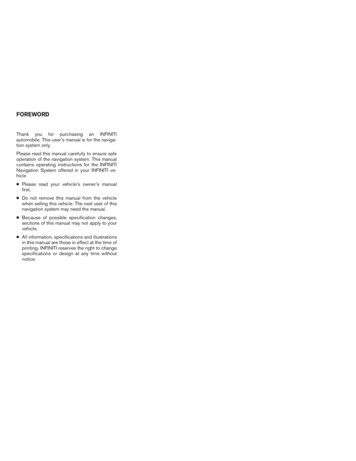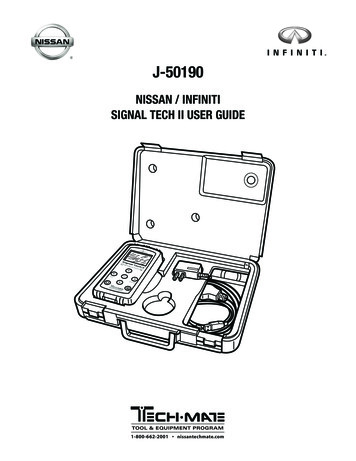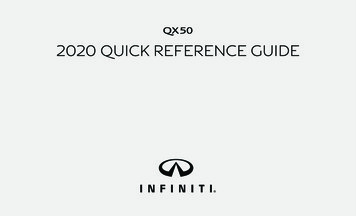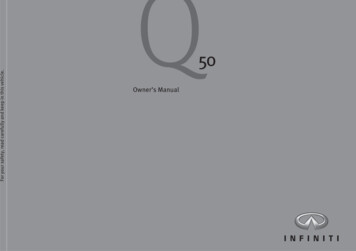
Transcription
For your safety, read carefully and keep in this vehicle.50Owner’s ManualQ
ForewordWelcome to the growing family of new INFINITI owners. This vehicle is delivered to you with confidence. It is produced using the latest techniques andstrict quality control.This manual was prepared to help you understand the operation and maintenance of your vehicle so that you may enjoy many kilometres (miles) of driving pleasure. Please read through this manual before operating your vehicle.A separate Warranty Information & Maintenance Booklet explains in detail the warranty coverage that applies to your vehicle.Your INFINITI Centre knows your vehicle best. When you require any service or have any questions, your INFINITI Centre will be glad to assist you with theextensive resources available for you.IMPORTANT SAFETY INFORMATIONMODIFICATION OF YOUR VEHICLEREMINDERS FOR SAFETY!This vehicle should not be modified. Modifications could affect its performance, safety or durability, and may even violate governmental regulations. In addition, damage or performance problems resulting from modifications may not be covered under INFINITI warranties.Follow these important driving rules to help ensure a safe and completetrip for you and your passengers! NEVER drive under the influence of alcohol or drugs. ALWAYS observe posted speed limits and never drive too fast for conditions. ALWAYS use your seat belts and appropriate child restraint systems. Preteenchildren should be seated in the rear seat. ALWAYS provide information about the proper use of vehicle safety features toREAD FIRST — THEN DRIVE SAFELYBefore driving your vehicle, read this Owner’s Manual carefully. This willensure familiarity with controls and maintenance requirements, assistingyou in the safe operation of your vehicle.Throughout this manual the following symbols and words are used:all occupants of the vehicle. ALWAYS review this Owner’s Manual for important safety information.WHEN READING THE MANUALThis manual includes information for all options available on this model.Therefore, you may find some information that does not apply to yourvehicle.All information, specifications and illustrations in this manual are those ineffect at the time of printing. INFINITI reserves the right to change specifications or designs at any time without notice and without obligation.WARNINGIndicates the presence of a hazard that could cause death or serious personal injury. To avoid or reduce the risk, the procedures described must be followed precisely.CAUTIONIndicates the presence of a hazard that could cause minor or moderate personalinjury, or damage to your vehicle. To avoid or reduce the risk, the procedures described must be followed carefully.NOTEIndicates additional helpful information.
Be sure to read the “Airbag warning labels” description in the Safety section of this manual; and the “Airbag label” description at the end of thismanual.This symbol means “Do not do this” or “Do not let this happen”.Arrows in an illustration that are similar to these point to the front of thevehicle.Arrows in an illustration that are similar to these indicate movement oraction.Arrows in an illustration that are similar to these call attention to an itemin the illustration.Air bag warning labels:BATTERY DISPOSALCAUTIONAn improperly disposed battery can harm the environment. Always confirm localregulations for battery disposal.Examples of the batteries that the vehicle contains: Vehicle battery Remote controller battery (for Intelligent Key and/or Remote keyless entry system) Tyre Pressure Monitoring System (TPMS) sensor battery Remote controller battery (for Mobile Entertainment system)If in doubt, contact your local authority, or an INFINITI Centre, or a qualified workshop for advice on disposal.INFINITI Genuine Parts and Accessories might be branded either INFINITIor NISSAN“NEVER use a rearward facing child restraint on a seat protected by anACTIVE AIRBAG in front of it, DEATH or SERIOUS INJURY to the CHILD canoccur.”
ContentsIllustrated table of contents0Safety — seats, seat belts and supplemental restraint system1Instruments and controls2Pre-driving checks and adjustments3Display screen, heater and air conditioner, and audio system4Starting and driving5In case of emergency6Appearance and care7Maintenance and do-it-yourself8Technical information9Index10
0 Illustrated table of contentsSeats, seat belts and Supplemental RestraintSystem (SRS).Exterior front .Exterior rear .Passenger compartment.Cockpit .Left-Hand Drive (LHD) model .Right-Hand Drive (RHD) model.0-20-30-40-50-60-60-8Instrument panel .Left-Hand Drive (LHD) model .Right-Hand Drive (RHD) model.Meters and gauges .Engine compartment .2.0L Turbo engine model.2.2L Diesel engine model .0-100-100-110-120-130-130-14
SEATS, SEAT BELTS AND SUPPLEMENTAL RESTRAINT SYSTEM (SRS)11. Front passenger air bag status light(P. 1-38)12. Front passenger air bag switch (P. 1-38)NIC20221.Child restraint anchorage (P. 1-18)2. Head restraints (P. 1-7)3. Seat belts (P. 1-11)4. Pre-tensioner seat belt system (P. 1-39)5.Supplemental curtain side-impact air bags(P. 1-31)6. Front seats (P. 1-2)7.Supplemental front-impact air bags(P. 1-31)8. ISOFIX child restraint system (P. 1-18)9. Rear seats (P. 1-6)— Child restraints (P. 1-18)10. Supplemental side-impact air bags (P. 1-31)0-2 Illustrated table of contents
EXTERIOR FRONT6. Outside rearview mirrors (P. 3-24)— Side turn signal light (P. 2-30)— Side view camera* (See the InfinitiInTouch Owner’s Manual)7.Recovery hook (P. 6-18)8. Parking sensor (sonar) system* (See theInfiniti InTouch Owner’s Manual)9. Front camera* (See the Infiniti InTouchOwner’s Manual)10. Front turn signal lights (P. 2-30)11. Front fog lights* (P. 2-31)12. Headlight cleaner* (P. 2-30)13. Tyres— Tyre Pressure Monitoring System(TPMS) (P. 2-7, P. 5-3)— Tyres and wheels (P. 8-29)— Flat tyre (P. 6-2)— Specifications (P. 9-7)JVC0620X1.— Switch operation (P. 2-26)— Adaptive Front lighting System (AFS)*(P. 2-29)— Maintenance (P. 8-22)Bonnet (P. 3-19)2. Windscreen wipers and washers— Switch operation (P. 2-32)— Blade replacement (P. 8-14)— Window washer fluid (P. 8-15)— Windscreen deicer* (P. 2-35)14. Doors— Keys (P. 3-2)— Door locks (P. 3-3)— Intelligent Key system (P. 3-6)— Security system (P. 3-17)— Courtesy light* (P. 2-45)*:where fitted4. Sunroof* (P. 2-38)5.Power windows (P. 2-36)3. HeadlightsIllustrated table of contents 0-3
EXTERIOR REAR9. Fuel filler lid— Operation (P. 3-22)— Fuel information (P. 9-4)10. Child safety rear door locks (P. 3-5)*:JVC0621X1.Boot— Boot lid (P. 3-21)— Battery (for 2.2L diesel engine) (P. 8-16)5.Parking sensor (sonar) system* (See theInfiniti InTouch Owner’s Manual)2. High-mounted stop light (P. 8-22)6. Rear view camera (See the Infiniti InTouchOwner’s Manual)3. DAB radio antenna* (P. 4-3)7.4. Rear window defogger (P. 2-34)/Antenna(P. 4-3)8. Rear combination light (P. 8-22)0-4 Illustrated table of contentsRecovery hook (P. 6-18)where fitted
PASSENGER COMPARTMENT10. Rear armrest/Boot pass-through (P. 1-7)11. Rear cup holders (P. 2-42)12. Rear ashtray* (P. 2-41)13. Console box (P. 2-42)— Power outlet (P. 2-40)— Media hub (See the Infiniti InTouchOwner’s Manual)14. Front cup holders (P. 2-43)15. Front passenger air bag status light(P. 2-12)*:where fittedJVC0425X1.Coat hooks (P. 2-43)2. Rear personal light (P. 2-45)3. Sun visors (P. 3-44)4. Map light (P. 2-45)5.Sunroof switch* (P. 2-38)6. Sunglasses holder (P. 2-42)7.Door armrest— Power windows controls (P. 2-36)— Power door lock switch (P. 3-5)— Outside rearview mirror remote controlswitch (P. 3-25)8. Automatic drive positioner switch* (P. 3-28)9. Inside rearview mirror (P. 3-24)Illustrated table of contents 0-5
COCKPIT6. Shift lever— Automatic Transmission (AT) (P. 5-12)— Manual Transmission (MT) (P. 5-16)7.INFINITI controller (See the Infiniti InTouchOwner’s Manual)8. Vehicle Dynamic Control (VDC) OFF switch(except for Europe) (P. 5-21) or ElectronicStability Programme (ESP) OFF switch(P. 5-23)9. Stop/Start OFF switch* or Idling Stop OFFswitch* (P. 5-29)10. Boot lid release switch (P. 3-21)11. Instrument brightness control switch(P. 2-3)12. TRIP/RESET switch for twin trip odometer(P. 2-2)13. Electric tilting/telescopic steering wheelswitch* (P. 3-24)JVC0622XLEFT-HAND DRIVE (LHD) MODEL1.— Power steering system (P. 5-110)— Horn (P. 2-36)— Driver’s supplemental front-impact airbag (P. 2-31)Side vent (P. 4-2)2. Headlight, fog light and turn signal switch— Headlight (P. 2-26)— Turn signal (P. 2-30)— Fog light (P. 2-31)3. Steering wheel0-6 Illustrated table of contents4. Windscreen wiper and washer switch(P. 2-32)5.Hazard indicator flasher switch (P. 6-2)14. Manual tilting/telescopic steering wheellever* (P. 3-23)15. Steering-wheel-mounted controls (leftside)— Audio control steering switch (See theInfiniti InTouch Owner’s Manual)— Hands-free phone system switch (Seethe Infiniti InTouch Owner’s Manual)— Voice recognition system switch (Seethe Infiniti InTouch Owner’s Manual)
16. Steering-wheel-mounted controls (rightside)— Trip computer switch (P. 2-23)— Speed limiter switches (P. 5-55)— Cruise control switches* (P. 5-57)— Intelligent Cruise Control (ICC) systemswitches* (P. 5-59, P. 5-74)— Dynamic driver assistance switch*(P. 5-34, P. 5-40, P. 5-90)17. INFINITI Drive Mode Selector (P. 5-17)*:where fittedIllustrated table of contents 0-7
— Power steering system (P. 5-110)— Horn (P. 2-36)— Driver’s supplemental front-impact airbag (P. 2-31)6. Windscreen wiper and washer switch(P. 2-32)7.Side vent (P. 4-2)8. INFINITI Drive Mode Selector (P. 5-17)9. Steering-wheel-mounted controls (leftside)— Audio control steering switch (See theInfiniti InTouch Owner’s Manual)— Hands-free phone system switch (Seethe Infiniti InTouch Owner’s Manual)— Voice recognition system switch (Seethe Infiniti InTouch Owner’s Manual)10. Electric tilting/telescopic steering wheelswitch* (P. 3-24)JVC0623XRIGHT-HAND DRIVE (RHD) MODEL1.INFINITI controller (See the Infiniti InTouchOwner’s Manual)2. Shift lever— Automatic Transmission (AT) (P. 5-12)— Manual Transmission (MT) (P. 5-16)3. Hazard indicator flasher switch (P. 6-2)0-8 Illustrated table of contents4. Headlight, fog light and turn signal switch— Headlight (P. 2-26)— Turn signal (P. 2-30)— Fog light (P. 2-31)5.Steering wheel11. Steering-wheel-mounted controls (rightside)— Trip computer switch (P. 2-23)— Speed limiter switches (P. 5-55)— Cruise control switches* (P. 5-57)— Intelligent Cruise Control (ICC) systemswitches* (P. 5-59, P. 5-74)— Dynamic driver assistance switch*(P. 5-34, P. 5-40, P. 5-90)12. Manual tilting/telescopic steering wheellever* (P. 3-23)
13. Instrument brightness control switch(P. 2-3)14. TRIP/RESET switch for twin trip odometer(P. 2-2)15. Boot lid release switch (P. 3-21)16. Stop/Start OFF switch (P. 5-29)17. Electronic Stability Programme (ESP) OFFswitch (P. 5-23)*:where fittedIllustrated table of contents 0-9
INSTRUMENT PANEL8. Defogger switch (P. 2-34)/Windscreendeicer switch* (P. 2-35)9. Front passenger’s supplemental frontimpact air bag (P. 2-31)10. Bonnet release handle (P. 3-19)11. Fuse box cover (P. 8-19)12. Parking brake pedal (Automatic Transmission (AT) model)— Operation (P. 3-27)— Parking (P. 5-106)— Maintenance (P. 8-11)13. Parking brake lever (Manual Transmission(MT) model)— Operation (P. 3-28)— Parking (P. 5-106)— Maintenance (P. 8-11)14. Ashtray and cigarette lighter* (P. 2-41) orStorage box (P. 2-41)JVC0624XLEFT-HAND DRIVE (LHD) MODEL1.5.Paddle shifter* (P. 5-14)2. Meters and gauges (P. 2-2)— Clock (P. 2-26)3. Push-button ignition switch (P. 5-7)4. Centre vent (P. 2-2)0-10 Illustrated table of contentsHeater and air conditioner (See the InfinitiInTouch Owner’s Manual)6. Upper touch screen display (upper display)and Navigation system* (See the InfinitiInTouch Owner’s Manual)7.Lower touch screen display (lower display)(See the Infiniti InTouch Owner’s Manual)15. Heated seat switches* (See the InfinitiInTouch Owner’s Manual)16. Audio system (See the Infiniti InTouchOwner’s Manual)17. Glove box lid release handle (P. 2-41)*:where fitted
8. Meters and gauges (P. 2-2)9. Paddle shifter* (P. 5-14)10. Glove box lid release handle (P. 2-41)11. Parking brake lever (Manual Transmission(MT) model)— Operation (P. 3-28)— Parking (P. 5-106)12. Storage box (P. 2-41)13. Heated seat switches* (See the InfinitiInTouch Owner’s Manual)14. Audio system (See the Infiniti InTouchOwner’s Manual)15. Parking brake pedal (Automatic Transmission (AT) model)— Operation (P. 3-27)— Parking (P. 5-106)16. Fuse box cover (P. 8-19)17. Bonnet release handle (P. 3-19)JVC0625XRIGHT-HAND DRIVE (RHD) MODEL1.Front passenger’s supplemental frontimpact air bag (P. 2-31)where fitted4. Lower touch screen display (lower display)(See the Infiniti InTouch Owner’s Manual)5.2. Heater and air conditioner (See the InfinitiInTouch Owner’s Manual)3. Defogger switch (P. 2-34)*:Upper touch screen display (upper display)and Navigation system* (See the InfinitiInTouch Owner’s Manual)6. Centre vent (P. 2-2)7.Push-button ignition switch (P. 5-7)Illustrated table of contents 0-11
METERS AND GAUGESJVC0502X1.Tachometer (P. 2-2)2. Warning/Indicator lights (P. 2-5)3. Speedometer (P. 2-2)4. Engine coolant temperature gauge (P. 2-3)0-12 Illustrated table of contents5.Vehicle information display (P. 2-15)— Odometer/twin trip odometer (P. 2-2)— Automatic Transmission (AT) positionindicator (where fitted) (P. 2-21)6. Fuel gauge (P. 2-3)
ENGINE COMPARTMENT10. Window washer fluid reservoir (P. 8-15)The auxiliary battery is located in the boot. (See“Battery” in the “8. Maintenance and do-it-yourself”section (P. 8-16.)*: The layout illustrated is for the Left-Hand Drive(LHD) model. On the Right-Hand Drive (RHD)model, these components are located on the opposite side.JVC0646X2.0L TURBO ENGINE MODEL1.Fuse and fusible link holder* (P. 8-19)6. Fuse and fusible link holder (P. 8-19)7.Engine oil dipstick (P. 8-7)2. Battery* (P. 8-16)8. Engine drive belt location (P. 8-9)3. Engine oil filler cap (P. 8-7)9. Power steering fluid reservoir (where fitted) (P. 8-14)4. Brake fluid reservoir* (P. 8-12)5.Engine coolant reservoir (P. 8-6)Illustrated table of contents 0-13
10. Window washer fluid reservoir (P. 8-15)The auxiliary battery is located in the boot. (See“Battery” in the “8. Maintenance and do-it-yourself”section (P. 8-16.)*: The layout illustrated is for the Left-Hand Drive(LHD) model. On the Right-Hand Drive (RHD)model, these components are located on the opposite side.JVC0626X2.2L Diesel ENGINE MODEL1.Fuse and fusible link holder* (P. 8-19)5.Engine coolant reservoir (P. 8-6)6. Fuse and fusible link holder (P. 8-19)Engine drive belt location (P. 8-9)2. Battery* (P. 8-16)7.3. Engine oil filler cap (P. 8-7)8. Engine oil dipstick (P. 8-7)4. Brake and clutch (where fitted) fluidreservoir* (P. 8-12)9. Power steering fluid reservoir (where fitted) (P. 8-14)0-14 Illustrated table of contents
1 Safety — seats, seat belts andsupplemental restraint systemSeats .Front seats.Rear seats.Armrest .Head restraints.Adjustable head restraint components .Non-adjustable head restraint components.Remove .Install.Adjust .Active head restraints (where fitted) .Seat belts.Precautions on seat belt usage.Child safety .Pregnant women .Injured persons.Pre-crash seat belts with comfort function(front seats) (where fitted) .Centre mark on seat belts 31-131-141-14Three-point type seat belt .Seat belt maintenance .Child restraints.Precautions on child restraints usage .Universal child restraints for front seat andrear seats .ISOFIX child restraint system.Child restraint anchorage.Child restraint installation using ISOFIX .Child restraint installation usingthree-point type seat belt .Supplemental restraint system .Precautions on Supplemental RestraintSystem (SRS) .Supplemental air bag systems .Pre-tensioner seat belt system .Repair and replacement procedure .Pop-up engine bonnet (where fitted) -391-401-41
SEATSSSS0133ZWARNING Do not drive and/or ride in the vehicle with theseatback reclined. This can be dangerous. Theshoulder belt will not be properly against the body.In an accident, you and your passengers could bethrown into the shoulder belt and receive neck orother serious injuries. You and your passengerscould also slide under the lap belt and receive serious injuries.For the most effective protection while the vehicleis in motion, the seatback should be upright. Always sit well back in the seat and adjust the seatproperly. See “Seat belts” later in this section.FRONT SEATSWARNINGDo not adjust the driver’s seat while driving so thatfull attention may be given to vehicle operation.Manual seat adjustmentWARNINGAfter adjusting a seat, gently shake the seat to confirm that the seat is locked securely. If the seat is notlocked securely, it may move suddenly and couldcause the loss of control of the vehicle.CAUTIONWhen adjusting the seat positions, be sure not to contact any moving parts to avoid possible injuries and/or damages.1-2 Safety — seats, seat belts and supplemental restraint system
Seat lifter:SSS0792ZSSS0793ZForward and backward:1 .1. Pull up the adjusting lever j2. Slide the seat to the desired position.3. Release the adjusting lever to lock the seat inposition.Reclining:1. Pull up the adjusting lever j2 .2. Tilt the seatback to the desired position.3. Release the adjusting lever to lock the seatback in position.The reclining feature allows the adjustment ofthe seatback for occupants of different sizes tohelp obtain the proper seat belt fit. (See “Seatbelts” later in this section.)The seatback may be reclined to allow occupantsto rest when the vehicle is parked.WARNINGThe seatback should not be reclined any more thanneeded for comfort. Seat belts are most effective whenthe passenger sits well back and straight up in theseat. If the seatback is reclined, the risk of slidingunder the lap belt and being injured is increased.Pull up or push down the adjusting lever to adjust the seat height until the desired position isachieved.Power seat adjustmentWARNINGNever leave children or adults who would normally require the support of others alone in the vehicle. Petsshould not be left alone either. They could unknowingly activate switches or controls and inadvertentlybecome involved in a serious accident and injurethemselves.Operating tips: The power seat motor has an auto-reset overloadprotection circuit. If the motor stops during the seatadjustment, wait 30 seconds, then reactivate theswitch.Safety — seats, seat belts and supplemental restraint system 1-3
To avoid discharge of the battery, do not operatethe power seats for a long period of time when theengine is not running.For the automatic drive positioner (where fitted)operation, see “Automatic drive positioner (wherefitted)” in the “3. Pre-driving checks and adjustments”section.SSS1051ZForward and backward:Move forward or backward the adjusting switchj1 to the desired position.Reclining:Move forward or backward the adjusting switchj2 to the desired position.The reclining feature allows the adjustment ofthe seatback for occupants of different sizes tohelp obtain the proper seat belt fit. (See “Seatbelts” later in this section.)The seatback may be reclined to allow occupantsto rest when the vehicle is parked.1-4 Safety — seats, seat belts and supplemental restraint systemWARNINGThe seatback should not be reclined any more thanneeded for comfort. Seat belts are most effective whenthe passenger sits well back and straight up in theseat. If the seatback is reclined, the risk of slidingunder the lap belt and being injured is increased.
The lumbar support feature provides lower backsupport to the driver.Side support (where fitted):Seat lifter:Power adjustment type (where fitted):SSS1052ZJVR0186XZ1. Pull up or push down the adjusting switch toadjust the seat height until the desired position is achieved.The side support feature allows you to adjustthe torso supports. Push the switch inside j1 oroutside j2 to adjust the torso area.2. Tilt up or down the adjusting switch to adjustthe front angle of the seat until the desiredposition is achieved.Lumbar support (where fitted)SSS1053The lumbar support feature provides lower backsupport to the driver.Push each side of the adjusting switch to adjustthe seat lumbar area until the desired positionis achieved.Manual adjustment type:SSS0684Z1 forward or backMove the adjusting lever jward to adjust the seat lumbar area until thedesired position is achieved.Safety — seats, seat belts and supplemental restraint system 1-5
Thigh extension (where fitted)SSS1057Z When returning the seatbacks to the upright position, be certain they are completely secured in thelatched position. If they are not completely secured, passengers may be injured in an accident orsudden stop. Closely supervise children when they are aroundcars to prevent them from playing and becominglocked in the boot where they could be seriouslyinjured. Keep the car locked, with the rear seatbackand boot lid securely latched when not in use, andprevent children’s access to car keys.The front portion of the front seats can be extended forward for seating comfort. Pull up andhold the lever j1 to extend the front portion tothe desired position.REAR SEATSFolding (where fitted)WARNING Never allow anyone to ride in the cargo area (boot)or on the rear seat when it is in the fold-down position. Use of these areas by passengers withoutproper restraints could result in serious injury inan accident or sudden stop.Properly secure all cargo with ropes or straps tohelp prevent it from sliding or shifting. Do notplace cargo higher than the seatbacks. In a sudden stop or collision, unsecured cargo could causepersonal injury.1-6 Safety — seats, seat belts and supplemental restraint systemJVR0195XThe rear seatback can be folded according to thefollowing procedure.Before folding the seatback: Disconnect and stow the centre seat belt andtongue into the retractor base. (See “Rear centreseat belt (models with rear seat folding)” later inthis section.)
HEAD RESTRAINTS Always reconnect the centre seat belt when the seatInterior boot accessWARNINGis returned to the upright position. Remove drink containers from the rear cup holder.To fold the seatback:1. Open the boot lid.2. Pull the strap located on the left and rightside of the boot. The rear seatback will beunlatched.3. Fold the rear seatback down.JVR0187XZTo return the seatback:The rear centre seatback can be folded to allowboot access from inside of the vehicle.1. Fold up the rear seatback.2. Securely lock the seatback in position.ARMRESTRearTo access the boot, pull down the rear centrearmrest and pull out the interior boot access lidj1 .To lock the lid, use the mechanical key and turnit to the lock position j2 . To unlock, turn the keyto the unlock position j3 . For the mechanicalkey usage, see “Keys” in the “3. Pre-driving checksand adjustments” section.Make sure that the key is removed from the access lid key cylinder before opening or closingthe interior boot access lid. Otherwise, the lidand the rear armrest may be damaged.SSS1061ZHead restraints supplement the other vehicle safetysystems. They may provide additional protectionagainst injury in certain rear end collisions. Adjust thehead restraints properly, as specified in this section.Check the adjustment after someone else uses theseat. Do not attach anything to the head restraintstalks or remove the head restraint. Do not use theseat if the head restraint has been removed. If thehead restraint was removed, reinstall and properly adjust the head restraint before an occupant uses theseating position. Failure to follow these instructionscan reduce the effectiveness of the head restraints.This may increase the risk of serious injury or death ina collision. Your vehicle is equipped with head restraints thatmay be integrated, adjustable or non-adjustable. Adjustable head restraints have multiple notchesalong the stalk to lock them in a desired adjustment position. The non-adjustable head restraints have a singlelocking notch to secure them to the seat frame. Proper Adjustment:– For the adjustable type, align the head restraint so the centre of your ear is approximately level with the centre of the headrestraint.Pull the armrest forward until it is horizontal.Safety — seats, seat belts and supplemental restraint system 1-7
– If your ear position is still higher than therecommended alignment, place the headrestraint at the highest position.NON-ADJUSTABLE HEAD RESTRAINTCOMPONENTSREMOVE If the head restraint has been removed, ensure thatit is reinstalled and locked in place before riding inthat designated seating position.ADJUSTABLE HEAD RESTRAINTCOMPONENTSSSS1037ZJVR0203XZ1. Removable head restraint2. Single notch3. Lock knobSSS0992Z4. Stalks1. Removable head restraint2. Multiple notches3. Lock knob4. Stalks1-8 Safety — seats, seat belts and supplemental restraint systemUse the following procedure to remove the headrestraint.1. Pull the head restraint up to the highest position.2. Push and hold the lock knob.3. Remove the head restraint from the seat.4. Store the head restraint properly in a secureplace so it is not loose in the vehicle.5. Reinstall and properly adjust the head restraint before an occupant uses the seatingposition.
INSTALLADJUSTthe lock knob is engaged in the notch beforeriding in that designated seating position.RaiseSSS1038Z1. Align the head restraint stalks with the holesin the seat. Make sure that the head restraintis facing the correct direction. The stalk withthe adjustment notch j1 must be installed inthe hole with the lock knob j2 .SSS0997ZFor adjustable head restraintSSS1035ZAdjust the head restraint so the centre is levelwith the centre of your ears. If your ear positionis still higher than the recommended alignment,place the head restraint at the highest position.2. Push and hold the lock knob and push thehead restraint down.To raise the head restraint, pull it up.Make sure the head restraint is positioned fromthe stored position or any non-latch position sothe lock knob is engaged in the notch beforeriding in that designated seating position.3. Properly adjust the head restraint before anoccupant uses the seating position.JVR0259XZFor non-adjustable head restraintMake sure the head restraint is positioned fromthe stored position or any non-latch position soSafety — seats, seat belts and supplemental restraint system 1-9
LowerACTIVE HEAD RESTRAINTS (where fitted)Active head restraints are effective to provideprotection at low to medium speeds in whichwhiplash injury seems to occur most.Active head restraints operate only in certainrear-end collisions. After the collision, the headrestraints return to their original positions.Properly adjust the active head restraints as described in the previous section.SSS1036ZTo lower, push and hold the lock knob and pushthe head restraint down.Make sure the head restraint is positioned sothe lock knob is engaged in the notch beforeriding in that designated seating position.SSS0508ZWARNING Failure to adjust the head restraint properly mayreduce the effectiveness of the active headrestraint. Always adjust the head restraint as described earlier in this section. Do not attach anything to the head restraint stalks.Doing so could impair the active head restraintfunction. Always wear seat belts. Active head restraints aredesigned to supplement other safety systems. Nosystem can prevent all injuries in any accident.The active head restraint moves forward utilising the force that the seatback receives from theoccupant in a rear-end collision. The movementof the head restraint helps support the front occupant’s head by reducing its backward movement and helps absorb some of the forces thatmay lead to whiplash type injuries.1-10 Safety — seats, seat belts and supplemental restraint system
SEAT BELTSPRECAUTIONS ON SEAT BELT USAGEIf you are wearing the seat belt properly adjustedand sitting upright and well back in the seat,chances of being injured or killed in an accidentand/or the severity of injury may be greatly reduced. INFINITI strongly encourages you and allof your passengers to
Tyre Pressure Monitoring System (TPMS) sensor battery Remote controller battery(for Mobile Entertainmentsystem) If in doubt, contact your local authority, or an INFINITI Centre, or a quali-fied workshop for advice on disposal. INFINITI Genuine Parts and Accessories might be branded either INFINITI orNISSAN
